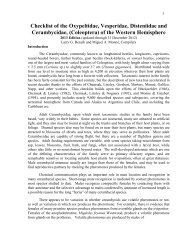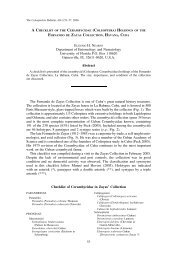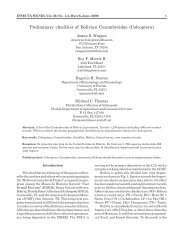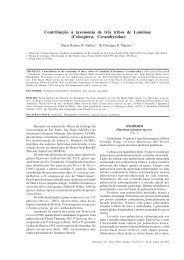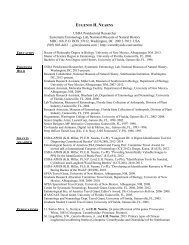Create successful ePaper yourself
Turn your PDF publications into a flip-book with our unique Google optimized e-Paper software.
LAWRENCE S. DILLON <strong>AND</strong> ELIZABETH S. DILLON 119<br />
tapering to apex, unarmed; apical and basal transverse sulci sinuous, the former<br />
less distinct than the latter, \vhich is merged into the lateral oblique ones; disk<br />
with five small, indistinct tubercles, sparsely punctate across bltSe. Scutellum feebly<br />
transverse; sides straight, slightly tapering; apex broad, indistinctly emarginate,<br />
not elevated laterally. Elytra gradually attenuatc posteriorly, sides straight, apicc.s<br />
separately rounded; humeri and much of base of disk occupied by a greatly elevated<br />
crest, which is about as hlgh as broad and brQader than long, placed slightly obliquely<br />
and armed at each angle of apex with a shining tubercle, the outer one of<br />
which is a little larger; disk between crest and suture with an elongate gibbosity,<br />
moderately sparsely and uniformly punctate, apical half of disk impundate; sides<br />
below humeri narrowly and indistinctly punctate. Prosternum simple, narrow.<br />
ProcoXfLe not tumid, with -a small, obtuse tubercle anteriorly; femora elongate,<br />
middle ones most strongly so, profemora more robust basally than others, not<br />
rugose; meta tibiae strongly expanded to apex. Fifth sternite one-half longer than<br />
fourth, apex retuse, impressed apically very feebly and broadly. Antennae slightly<br />
shorter than body, very sparsely fimbriate beneath to apex; seape elongate, slender,<br />
only feebly clavate apically ; third segment a little shorter than first, broadly and<br />
indistinctly arcuate downward from base to apex; eleventh shorter than tenth,<br />
simple, its tip gradually attenuate.<br />
LENGTH 14 mm.; width 8 mm. across humeral crest., 5.5 mm. behind crest.<br />
'l.'ype locality.-Brazil.<br />
Distrib1tion.-Southea.stern BraziL<br />
BRAZIL: ; Rio de Janeiro, 1883; [A.N.S.P.}.<br />
ALEXERA Dillon and Dillon, gen, nov,<br />
Somewhat related to Plerodia but is distinguished by the larger<br />
size of body; the antennae much longer than body in male, sea pe<br />
more strongly clavate ; eye with lower lobe twice height of gena;<br />
elytra more strongly attenuate, humeri obtusely tubercled, the<br />
carina extending strongly behind middle of elytron ; prosternnm<br />
broad j and metatibiae DOt expanded in male. There is a strong<br />
resemblance in the eJytral maculation to H esycha.<br />
Moderate-sized, elongate-ovate, robust. Head with front rather narrow, sides<br />
only slightly oblique, nearly parallel ; gena. vertical, oblong; eye with lower lobe<br />
large, twice the height of gena, oblong, slightly narrowed below; antennal tubercles<br />
well separated, prominent, apex in male with a short, robust horn bent slightly<br />
posteriorly. Pronotum transverse, slightly conical, apex narrower than base, unarmed<br />
laterally; disk tuberculatc. Scutellum transverse. Elytra with sides nearly<br />
straight, moderately attenuate apically; apices each narrowly rounded; disk with<br />
,basal gibbosity broad, feebly elevated, simply punctate at base; humeri prominent,<br />
with an obtuse tubercle, followed by a long carina to behind middle of elytron.<br />
Prosternum broad, simple; mesosternal proces.:; broad, sides emarginate, slightly<br />
widened apically, deeply, bilobedly emarginate at apex. Legs moderately long;



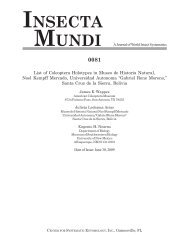
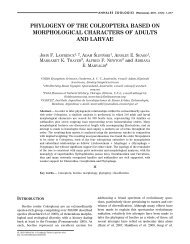


![Coleoptera. Vol. I. [Longicornia. Part I.]](https://img.yumpu.com/41202793/1/180x260/coleoptera-vol-i-longicornia-part-i.jpg?quality=85)

